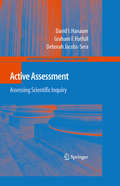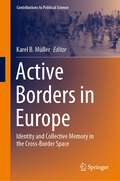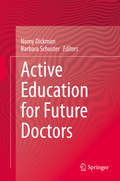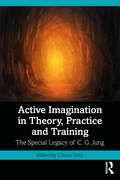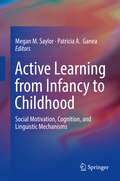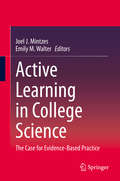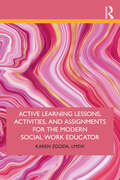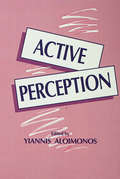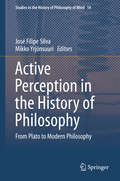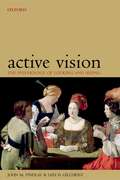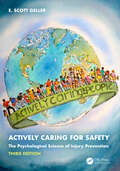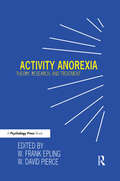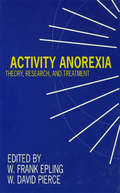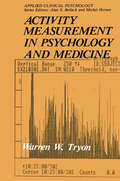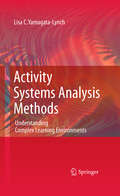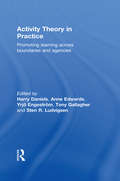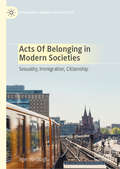- Table View
- List View
Active Assessment: Assessing Scientific Inquiry (Mentoring in Academia and Industry #2)
by David I. Hanauer Debbie Jacobs-Sera Graham F. HatfullThe term scienti?c inquiry as manifest in different educational settings covers a wide range of diverse activities. The differences in types of scienti?c inquiry can be organized along a continuum according to the degree of teacher control and intellectual sophistication involved in each type of inquiry. Types of scienti?c inquiry can also be de?ned according to whether they produce cultural knowledge or personal knowledge. Authentic scienti?c inquiry is de?ned according to ?ve characteristics: devel- ment of personal and cultural knowledge; contextualized scienti?c knowledge; the progression toward high-order problem solving; social interaction for s- enti?c goals; and scienti?c inquiry as a multi-stage and multi-representational process. The de?nition of scienti?c inquiry that forms the basis for the development of an assessment program consists of a two-part analytical frame: the de?nition of knowledge types relevant to scienti?c inquiry and the de?nition of an organi- tional frame for these knowledge types. Four types of knowledge are signi?cant for the de?nition of a speci?c s- enti?c inquiry program: cognitive knowledge, physical knowledge, represen- tional knowledge, and presentational knowledge. All four of these knowledge types are considered signi?cant. These four types of knowledge are organized in a framework that consists of two intersecting axes: the axis of knowledge types and the axis of stages of a s- ci?c scienti?c inquiry. This framework describes scienti?c inquiry as multi-stage process that involves the development of a series of in-lab outcomes (represen- tions) over an extended period of time.
Active Borders in Europe: Identity and Collective Memory in the Cross-Border Space (Contributions to Political Science)
by Karel B. MüllerThis book explores how identities, public spheres and collective memories are being transformed in cross-border areas, contributing to the broad sociological context of Europeanization. Offering case studies on the German-Czech-Austrian, and Czech-Polish-German borderlands, the book introduces original primary data on cross-border cooperation. This data is interpreted using the concept of active borders, which approaches borders as a source of multicultural competence and cognitive capacity. In turn, the authors argue that Europeans need to treat borders, both territorial and symbolic, as specific cultural forms. Active borders allow an unprecedented level of cross-border cooperation and integration, and foster a better understanding of differences, rather than re-embedding them or constructing others. Accordingly, the authors contend that active borders promote more dynamic, open and resilient societies, and represent crucial prerequisites for the success of the European integration project.
Active Education for Future Doctors
by Nomy Dickman Barbara SchusterThis book is designed to aid the faculty of medical and other health related schools in developing the pedagogical skills to transform their teaching in multiple settings including the classroom, the conference room, the ambulatory office, and the hospital from a passive learning experience to an active learning experience. In this transformation, the teacher morphs from the ‘all knowing expert’ to the ‘learning facilitator and coach’. After a brief review of adult learning theory the remainder of the book will focus on a broad variety of teaching techniques and classroom activities that ‘flip’ the classroom from a passive to an active learning environment. In addition to condensed explanations of each of the techniques, examples of each process will be presented with suggestions for flexing the techniques to better accommodate a variety of learning settings and a diversity of learners.
Active Imagination in Theory, Practice and Training: The Special Legacy of C. G. Jung
by Chiara TozziBased on extensive research and developed with the support of the IAAP, this fascinating new work presents the precious value of the special legacy of C.G. Jung, which he himself defined as Active Imagination, through a collection of unpublished contributions by some of the brightest Jungian analysts and renowned representatives from the worlds of Art, Culture, Physics and Neurosciences.In addition to presenting the genesis, development and results of Chiara Tozzi's research on Active Imagination, this volume on Theory, Practice and Training will also include the fundamental theoretical aspects of this technique. The book explores Active Imagination in relation to fundamental contents of Analytical Psychology, such as Individuation, Transformation and comparison with the Shadow, the four psychological functions, C.G. Jung's Red Book, and more. Moreover, the connections between Active Imagination and Sandplay will also be explored, as well as the possibilities of applying the technique with adolescent patients, how it’s considered and proposed in Jungian Training, and some innovative clinical methodologies of Active Imagination.Spanning two volumes, which are also accessible as stand alone books, this essential collection will be of great interest to Jungian analysts, psychologists, psychoanalysts, or anyone interested in discovering more about the fascinating psychotherapeutic practice of Active Imagination and its interdisciplinary uses.
Active Imagination in Theory, Practice and Training: The Special Legacy of C. G. Jung
by Chiara TozziBased on extensive research and developed with the support of the IAAP, this fascinating new work presents the precious value of the special legacy of C.G. Jung, which he himself defined as Active Imagination, through a collection of unpublished contributions by some of the brightest Jungian analysts and renowned representatives from the worlds of Art, Culture, Physics and Neurosciences.In addition to presenting the genesis, development and results of Chiara Tozzi's research on Active Imagination, this volume on Theory, Practice and Training will also include the fundamental theoretical aspects of this technique. The book explores Active Imagination in relation to fundamental contents of Analytical Psychology, such as Individuation, Transformation and comparison with the Shadow, the four psychological functions, C.G. Jung's Red Book, and more. Moreover, the connections between Active Imagination and Sandplay will also be explored, as well as the possibilities of applying the technique with adolescent patients, how it’s considered and proposed in Jungian Training, and some innovative clinical methodologies of Active Imagination.Spanning two volumes, which are also accessible as stand alone books, this essential collection will be of great interest to Jungian analysts, psychologists, psychoanalysts, or anyone interested in discovering more about the fascinating psychotherapeutic practice of Active Imagination and its interdisciplinary uses.
Active Learning from Infancy to Childhood: Social Motivation, Cognition, and Linguistic Mechanisms
by Patricia A. Ganea Megan M. SaylorThis book presents new findings on the role of active learning in infants’ and young children’s cognitive and linguistic development. Chapters discuss evidence-based models, identify possible neurological mechanisms supporting active learning, pinpoint children’s early understanding of learning, and trace children’s recognition of their own learning. Chapters also address how children shape their lexicon, covering a range of active learning practices including interactions with parents, teachers, and peers; curiosity and exploration during play; seeking information from other people and their surroundings; and asking questions. In addition, processes of selective learning are discussed, from learning new words and trusting others in acquiring information to weighing evidence and accepting ambiguity. Topics featured in this book include:Infants’ active role in language learning.The process of active word learning.Understanding when and how explanation promotes exploration.How conversations with parents can affect children’s word associations.Evidence evaluation for active learning and teaching in early childhood.Bilingual children and their role as language brokers for their parents.Active Learning from Infancy to Childhood is a must-have resource for researchers, clinicians and related professionals, and graduate students in developmental psychology, psycholinguistics, educational psychology, and early childhood education.
Active Learning in College Science: The Case for Evidence-Based Practice
by Joel J. Mintzes Emily M. WalterThis book explores evidence-based practice in college science teaching. It is grounded in disciplinary education research by practicing scientists who have chosen to take Wieman’s (2014) challenge seriously, and to investigate claims about the efficacy of alternative strategies in college science teaching. In editing this book, we have chosen to showcase outstanding cases of exemplary practice supported by solid evidence, and to include practitioners who offer models of teaching and learning that meet the high standards of the scientific disciplines. Our intention is to let these distinguished scientists speak for themselves and to offer authentic guidance to those who seek models of excellence. Our primary audience consists of the thousands of dedicated faculty and graduate students who teach undergraduate science at community and technical colleges, 4-year liberal arts institutions, comprehensive regional campuses, and flagship research universities. In keeping with Wieman’s challenge, our primary focus has been on identifying classroom practices that encourage and support meaningful learning and conceptual understanding in the natural sciences. The content is structured as follows: after an Introduction based on Constructivist Learning Theory (Section I), the practices we explore are Eliciting Ideas and Encouraging Reflection (Section II); Using Clickers to Engage Students (Section III); Supporting Peer Interaction through Small Group Activities (Section IV); Restructuring Curriculum and Instruction (Section V); Rethinking the Physical Environment (Section VI); Enhancing Understanding with Technology (Section VII), and Assessing Understanding (Section VIII). The book’s final section (IX) is devoted to Professional Issues facing college and university faculty who choose to adopt active learning in their courses. The common feature underlying all of the strategies described in this book is their emphasis on actively engaging students who seek to make sense of natural objects and events. Many of the strategies we highlight emerge from a constructivist view of learning that has gained widespread acceptance in recent years. In this view, learners make sense of the world by forging connections between new ideas and those that are part of their existing knowledge base. For most students, that knowledge base is riddled with a host of naïve notions, misconceptions and alternative conceptions they have acquired throughout their lives. To a considerable extent, the job of the teacher is to coax out these ideas; to help students understand how their ideas differ from the scientifically accepted view; to assist as students restructure and reconcile their newly acquired knowledge; and to provide opportunities for students to evaluate what they have learned and apply it in novel circumstances. Clearly, this prescription demands far more than most college and university scientists have been prepared for.
Active Learning Lessons, Activities, and Assignments for the Modern Social Work Educator
by Karen ZgodaThis text infuses the field of social work with dynamic and evidence-based active learning, offering fresh ideas to increase students’ abilities to effectively implement their social work practice. To practice social work in the real world, students need to be energized and engaged with the realities of the modern social work landscape. Written in an accessible and practical style, the impressive array of contributors provide social work educators with structured lesson plans, practice exercises, and assignments that can be used in both the physical and virtual classroom. Combining the latest research with current social work practice trends, the chapters cover cutting-edge topics such as ethics, social work technology, the importance of self-care, and social justice and activism, bridging the gap between current social work education and the needs of the modern social work student. This book is invaluable reading for both social work educators and their students, providing tools to seamlessly integrate innovative techniques into the classroom as well as helping their students navigate a career in social work after graduation.
Active Learning Lessons, Activities, and Assignments for the Modern Social Work Educator
by Karen ZgodaThis text infuses the field of social work with dynamic and evidence-based active learning, offering fresh ideas to increase students’ abilities to effectively implement their social work practice. To practice social work in the real world, students need to be energized and engaged with the realities of the modern social work landscape. Written in an accessible and practical style, the impressive array of contributors provide social work educators with structured lesson plans, practice exercises, and assignments that can be used in both the physical and virtual classroom. Combining the latest research with current social work practice trends, the chapters cover cutting-edge topics such as ethics, social work technology, the importance of self-care, and social justice and activism, bridging the gap between current social work education and the needs of the modern social work student. This book is invaluable reading for both social work educators and their students, providing tools to seamlessly integrate innovative techniques into the classroom as well as helping their students navigate a career in social work after graduation.
Active Perception (Computer Vision Series)
by Yiannis AloimonosThis book defines the emerging field of Active Perception which calls for studying perception coupled with action. It is devoted to technical problems related to the design and analysis of intelligent systems possessing perception such as the existing biological organisms and the "seeing" machines of the future. Since the appearance of the first technical results on active vision, researchers began to realize that perception -- and intelligence in general -- is not transcendental and disembodied. It is becoming clear that in the effort to build intelligent visual systems, consideration must be given to the fact that perception is intimately related to the physiology of the perceiver and the tasks that it performs. This viewpoint -- known as Purposive, Qualitative, or Animate Vision -- is the natural evolution of the principles of Active Vision. The seven chapters in this volume present various aspects of active perception, ranging from general principles and methodological matters to technical issues related to navigation, manipulation, recognition, learning, planning, reasoning, and topics related to the neurophysiology of intelligent systems.
Active Perception (Computer Vision Series)
by Yiannis AloimonosThis book defines the emerging field of Active Perception which calls for studying perception coupled with action. It is devoted to technical problems related to the design and analysis of intelligent systems possessing perception such as the existing biological organisms and the "seeing" machines of the future. Since the appearance of the first technical results on active vision, researchers began to realize that perception -- and intelligence in general -- is not transcendental and disembodied. It is becoming clear that in the effort to build intelligent visual systems, consideration must be given to the fact that perception is intimately related to the physiology of the perceiver and the tasks that it performs. This viewpoint -- known as Purposive, Qualitative, or Animate Vision -- is the natural evolution of the principles of Active Vision. The seven chapters in this volume present various aspects of active perception, ranging from general principles and methodological matters to technical issues related to navigation, manipulation, recognition, learning, planning, reasoning, and topics related to the neurophysiology of intelligent systems.
Active Perception in the History of Philosophy: From Plato to Modern Philosophy (Studies in the History of Philosophy of Mind #14)
by José Filipe Silva Mikko YrjönsuuriThe aim of the present work is to show the roots of the conception of perception as an active process, tracing the history of its development from Plato to modern philosophy. The contributors inquire into what activity is taken to mean in different theories, challenging traditional historical accounts of perception that stress the passivity of percipients in coming to know the external world. Special attention is paid to the psychological and physiological mechanisms of perception, rational and non-rational perception and the role of awareness in the perceptual process.Perception has often been conceived as a process in which the passive aspects - such as the reception of sensory stimuli - were stressed and the active ones overlooked. However, during recent decades research in cognitive science and philosophy of mind has emphasized the activity of the subject in the process of sense perception, often associating this activity to the notions of attention and intentionality. Although it is recognized that there are ancient roots to the view that perception is fundamentally active, the history remains largely unexplored.The book is directed to all those interested in contemporary debates in the fields of philosophy of mind and cognitive psychology who would like to become acquainted with the historical background of active perception, but for historical reliability the aim is to make no compromises.
Active Support: Enabling and Empowering People with Intellectual Disabilities
by Jim Mansell Julie Beadle-BrownActive Support is a proven model of care that enables and empowers people with intellectual disabilities to participate in all aspects of their lives. This evidence-based approach is particularly effective for working with people with more severe disabilities, and is of growing interest to those responsible for providing support and services.
Active Vision: The Psychology Of Looking And Seeing (Oxford Psychology Series #37)
by John M. Findlay Iain D. GilchristMore than one third of the human brain is devoted to the processes of seeing - vision is after all the main way in which we gather information about the world. But human vision is a dynamic process during which the eyes continually sample the environment. Where most books on vision consider it as a passive activity, this book is unique in focusing on vision as an 'active' process. It goes beyond most accounts of vision where the focus is on seeing, to provide an integrated account of seeing AND looking. The book starts by pointing out the weaknesses in our traditional approaches to vision and the reason we need this new approach. It then gives a thorough description of basic details of the visual and oculomotor systems necessary to understand active vision. The book goes on to show how this approach can give a new perspective on visual attention, and how the approach has progressed in the areas of visual orienting, reading, visual search, scene perception and neuropsychology. Finally, the book summarises progress by showing how this approach sheds new light on the old problem of how we maintain perception of a stable visual world. Written by two leading vision scientists, this book will be valuable for vision researchers and psychology students, from undergraduate level upwards.
Actively Caring for Safety: The Psychological Science of Injury Prevention
by E. Scott GellerActively Caring for Safety: The Psychological Science of Injury Prevention outlines proactive applications of applied behavioural science and humanism (i.e., humanistic behaviourism) for improving health and safety. This text provides evidence-based principles for customizing effective processes for improving the human dynamics of safety and health in various locations—from home to the workplace, and throughout a community. World-renowned health/safety researcher, teacher, and consultant E. Scott Geller combines theory and principles in practical step-by-step procedures with behavioral science methods capable of enhancing safety awareness, reducing at-risk behavior, and facilitating ongoing participation in safety-related activities. Drawing upon his bestselling works Working Safe and The Psychology of Safety Handbook, this book presents a science-based and practical approach to improving attitudes and behavior for achieving an injury-free work environment. The text has been improved and updated throughout and includes additional material on a rationale for language to replace common safety-related words that stifle human engagement. Plus, critical safety-relevant information is provided on empathy, emotional intelligence, self-motivation, positive psychology, psychological safety, the dramatic benefits of promoting perceptions of personal choice, and critical distinctions between leadership and management for optimizing workplace safety and productivity.Written in an enjoyable, anecdotal, and engaging style, this is an essential read for any student, academic, researcher, or professional of health and safety.
Actively Caring for Safety: The Psychological Science of Injury Prevention
by E. Scott GellerActively Caring for Safety: The Psychological Science of Injury Prevention outlines proactive applications of applied behavioural science and humanism (i.e., humanistic behaviourism) for improving health and safety. This text provides evidence-based principles for customizing effective processes for improving the human dynamics of safety and health in various locations—from home to the workplace, and throughout a community. World-renowned health/safety researcher, teacher, and consultant E. Scott Geller combines theory and principles in practical step-by-step procedures with behavioral science methods capable of enhancing safety awareness, reducing at-risk behavior, and facilitating ongoing participation in safety-related activities. Drawing upon his bestselling works Working Safe and The Psychology of Safety Handbook, this book presents a science-based and practical approach to improving attitudes and behavior for achieving an injury-free work environment. The text has been improved and updated throughout and includes additional material on a rationale for language to replace common safety-related words that stifle human engagement. Plus, critical safety-relevant information is provided on empathy, emotional intelligence, self-motivation, positive psychology, psychological safety, the dramatic benefits of promoting perceptions of personal choice, and critical distinctions between leadership and management for optimizing workplace safety and productivity.Written in an enjoyable, anecdotal, and engaging style, this is an essential read for any student, academic, researcher, or professional of health and safety.
Activities for Adults with Learning Disabilities: Having Fun, Meeting Needs
by Helen Sonnet Ann TaylorThis valuable resource for people working with adults with learning disabilities provides over 60 sessions of fun activities that aim to entertain and stimulate the minds of people with learning disabilities. The sessions are divided into different types of activity including cookery, arts and crafts, drama and dance, and outside events.
Activity Anorexia: Theory, Research, and Treatment
by W. Frank Epling W. David PierceThis volume provides researchers and clinicians with an insight into recent developments in activity anorexia. Much of the basic information on the topic has come from animal literature; the theory of activity anorexia is built on an animal model of self-starvation (rats placed on a single daily feeding run more and more, over days stop eating, and die of starvation). Additionally, experiments that for ethical or practical reasons could not be done with humans may be conducted with other animals. The animal research is extending the understanding of biologically-based reward mechanisms that regulate eating and exercise, environment-behavior interactions that affect anorexia, and the biochemical changes that accompany physical activity and starvation. Increasingly, however, the impact of physical activity on human anorexia is being directly investigated--eight out of fourteen research chapters in this volume are based on human research. Some researchers are interested in the impact of hyperactivity and caloric restriction on human reproductive function. Other authors are investigating physically active subgroups of people considered to be at risk for anorexia. Finally, several clinician/researchers suggest how physical activity and extreme dieting interact for anorexia nervosa patients. Chapter authors were asked to present their views independent of the editors' argument that, when it is present, physical activity is central to anorexia. Many of the contributors disagree with the editors about the details of activity anorexia. A few suggest that excessive physical activity is either incidental to, or an epiphenomenon of, anorexia. Most authors are, however, in accord with the view that physical activity reduces food consumption which further drives up activity that results in even less caloric intake. No matter what their perspective, all contributors agree that hyperactivity frequently accompanies self-starvation in humans and other animals. The end result is a lively book that provides a source of ideas for both researchers and practitioners.
Activity Anorexia: Theory, Research, and Treatment
by W. David Pierce W. Frank EplingThis volume provides researchers and clinicians with an insight into recent developments in activity anorexia. Much of the basic information on the topic has come from animal literature; the theory of activity anorexia is built on an animal model of self-starvation (rats placed on a single daily feeding run more and more, over days stop eating, and die of starvation). Additionally, experiments that for ethical or practical reasons could not be done with humans may be conducted with other animals. The animal research is extending the understanding of biologically-based reward mechanisms that regulate eating and exercise, environment-behavior interactions that affect anorexia, and the biochemical changes that accompany physical activity and starvation. Increasingly, however, the impact of physical activity on human anorexia is being directly investigated--eight out of fourteen research chapters in this volume are based on human research. Some researchers are interested in the impact of hyperactivity and caloric restriction on human reproductive function. Other authors are investigating physically active subgroups of people considered to be at risk for anorexia. Finally, several clinician/researchers suggest how physical activity and extreme dieting interact for anorexia nervosa patients. Chapter authors were asked to present their views independent of the editors' argument that, when it is present, physical activity is central to anorexia. Many of the contributors disagree with the editors about the details of activity anorexia. A few suggest that excessive physical activity is either incidental to, or an epiphenomenon of, anorexia. Most authors are, however, in accord with the view that physical activity reduces food consumption which further drives up activity that results in even less caloric intake. No matter what their perspective, all contributors agree that hyperactivity frequently accompanies self-starvation in humans and other animals. The end result is a lively book that provides a source of ideas for both researchers and practitioners.
Activity for Mental Health
by Brad BowinsActivity For Mental Health explores all activities, including physical, social, natural, cognitive, art/hobby and music as a means to both preventing and treating mental illness. This book not only reviews evidence-based research behind activity, but also explores how these forms of activity can treat mental illnesses. First, the reader is introduced to the concepts of Formal Behavioral Activation Therapy (BAT) and informal activity as an effective treatment option. Case examples aid in connecting the benefits to real life scenarios. Following the introduction, each activity is introduced in separate chapters, including physical, social, natural, cognitive, art/hobby and music. This book will provide researchers and clinicians the information needed to help customize treatment options for their patients suffering from mental illness. - Evaluates the effectiveness of Behavioral Activation Therapy (BAT) as compared to existing psychotherapy treatments - Advocates creative activities to improve depression and anxiety - Includes multiple case studies detailing experiences with BAT and other therapies - Examines the relationship between physical activity and the nervous system, thus reducing sympathetic system stress responses - Explores the role of cognitive activity in predicting cognitive health
Activity Measurement in Psychology and Medicine (Nato Science Series B:)
by Warren W. TryonIn his treatment of activity measurement in the fields of medicine and psychology, Tryon gives us a book that clearly accomplishes the three purposes set out in its preface. The reader is definitely encouraged to wrestle with the concepts ofbehavior and activity in terms of "dynamic physical quantities." Moreover, the reader cannot help but become familiarized with the technology available for performing activity measurements. Motivation to use some of this technology is enhanced by the very extensive summary of other people's uses of it provided throughout the book. Readers may find the book provocative on a number of Ievels. It is concep tually provocative to those of us struggling with understanding basic issues in the assessment and measurement of behavior. It is practically provocative to those of us working with various forms of behavioral difference, especially in clinical popula tions. The book provokes because it is essentially an unfinished exploration, open ing us to numerous pathways that, when traveled, reveal still more paths to explore. In this sense the book should be heuristically useful both in the more traditional empirical sense, and in terms of its Stimulation of conceptual discussion.
Activity Systems Analysis Methods: Understanding Complex Learning Environments
by Lisa C. Yamagata-LynchIn the last two decades, there has been growing interest in pursuing theoretical paradigms that capture complex learning situations. Cultural Historical Activity Theory (CHAT) is one of several theoretical frameworks that became very popular among educational researchers because it conceptualizes individuals and their environment as a holistic unit of analysis. It assumes a non-dualistic ontology and acknowledges the complexities involved in human activity in natural settings. Recently, reputable journals such as the American Psychologist, Educational Psychologist, and Educational Researcher that are targeted for a wide-range of audience have included articles on CHAT. In many of such articles, CHAT has been referred to as social constructivism, sociocultural theory, or activity theory. Activity systems analysis is one of the popular methods among CHAT researchers for mapping complex human interactions from qualitative data. However, understanding the methods involved in activity systems analysis is a challenging task for many researchers. This difficulty derives from several reasons. First the original texts of CHAT are in Russian and there have been numerous authors who report on the difficulties of reconciling translation problems of the works of original authors’ such as Vygotsky and Leontiev. Second, in North America activity systems analysis has deviated from the Russian scholars’ intentions and Engeström’s original work using the triangle model to identify tensions to overcome and bring about sociopolitical change in participant practices. Third, to this date there are numerous publications on the theoretical background of activity theory and studies reporting the results of using activity systems analysis for unpacking qualitative data sets, but there have been no methodological publications on how researchers engage in activity systems analysis. Thus, there is a dearth of literature in both book and journal publications that guide researchers on the methodological issues involving activity systems analysis.
Activity Theory in Practice: Promoting Learning Across Boundaries and Agencies
by Harry Daniels Anne Edwards Yrjö Engeström Tony Gallagher Sten R. LudvigsenThis ground-breaking book brings together cutting-edge researchers who study the transformation of practice through the enhancement and transformation of expertise. This is an important moment for such a contribution because expertise is in transition - moving toward collaboration in inter-organizational fields and continuous shaping of transformations. To understand and master this transition, powerful new conceptual tools are needed and are provided here. The theoretical framework which has shaped these studies is Cultural Historical Activity Theory (CHAT). CHAT analyses how people and organisations learn to do something new, and how both individuals and organisations change. The theoretical and methodological tools used have their origins in the work of Lev Vygotsky and A.N. Leont’ev. In recent years this body of work has aroused significant interest across the social sciences, management and communication studies. Working as part of an integrated international team, the authors identify specific findings which are of direct interest to the academic community, such as: the analysis of vertical learning between operational and strategic levels within complex organizations; the refinement of notions of identity and subject position within CHAT; the introduction of the concept of ‘labour power’ into CHAT; the development of a method of analysing discourse which theoretically coheres with CHAT and the design of projects. Activity Theory in Practice will be highly useful to practitioners, researchers, students and policy-makers who are interested in conceptual and empirical issues in all aspects of ‘activity-based’ research.
Activity Theory in Practice: Promoting Learning Across Boundaries and Agencies
by Harry Daniels Anne Edwards Tony Gallagher Sten R. Ludvigsen Yrjo EngeströmThis ground-breaking book brings together cutting-edge researchers who study the transformation of practice through the enhancement and transformation of expertise. This is an important moment for such a contribution because expertise is in transition - moving toward collaboration in inter-organizational fields and continuous shaping of transformations. To understand and master this transition, powerful new conceptual tools are needed and are provided here. The theoretical framework which has shaped these studies is Cultural Historical Activity Theory (CHAT). CHAT analyses how people and organisations learn to do something new, and how both individuals and organisations change. The theoretical and methodological tools used have their origins in the work of Lev Vygotsky and A.N. Leont’ev. In recent years this body of work has aroused significant interest across the social sciences, management and communication studies. Working as part of an integrated international team, the authors identify specific findings which are of direct interest to the academic community, such as: the analysis of vertical learning between operational and strategic levels within complex organizations; the refinement of notions of identity and subject position within CHAT; the introduction of the concept of ‘labour power’ into CHAT; the development of a method of analysing discourse which theoretically coheres with CHAT and the design of projects. Activity Theory in Practice will be highly useful to practitioners, researchers, students and policy-makers who are interested in conceptual and empirical issues in all aspects of ‘activity-based’ research.
Acts of Belonging in Modern Societies: Sexuality, Immigration, Citizenship (Citizenship, Gender and Diversity)
by Ilgın YörükoğluThis book examines the ways in which the need to belong manifests itself in the post 9/11 world, from a cross-disciplinary perspective. Using queer Turkish women in Berlin as its subjects, the book shows how individuals with seemingly contradictory belongings develop strategies of emotional survival in the face of conflict, which Yorukoglu terms “acts of belonging”. It studies the impact of populist discourses on minorities, exploring concepts such as security, integration, sexual tolerance and cohesion within a causal relationship. Questioning this assumed relationship, the book proposes an alternative approach to study belonging. Acts Of Belonging in Modern Societies supports the empirical research behind the argument that cohesion is not a "sine qua non" of belonging. These acts allow the individual to claim belonging in spite of possible differences. The book provides evocative case studies to reveal the affective, dynamic, complex nature of human connectedness.
